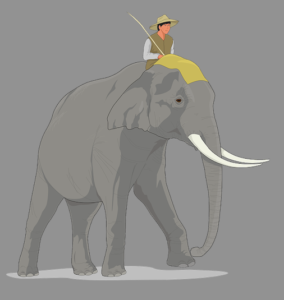I recently completed reading a book, “Switch” that focuses on the topic of change and found the following concept/notes valuable. We see this play out everyday.
Conventional wisdom in psychology is that the brain has two independent systems at work all the times.
- the emotional side – part of you that is instinctive, that feels pain and pleasure.
- the rational side, also known as the reflective or conscious system – part of you that deliberates and analyzes, and looks into the future.
The duo’s tension is captured by an analogy in University of Virginia psychologist Jonathan Haidt’s The Happiness Hypothesis book.
Our emotional side is an Elephant and our rational side is its Rider.
Perched atop the Elephant, the Rider holds the reins and seems to be the leader. But the Rider’s control is precarious because the Rider is so small relative to the Elephant. Anytime, the Elephant and the Rider disagree abut which direction to go, the Rider is going to lose. He’s completely overmatched.
Most of us are familiar with situations in which our Elephant overpowers our Rider. The weakness of the Elephant, our emotional and instinctive side, is clear. It’s often looking for the quick pay-off (ice cream) over the long-term payoff (being thin).
When change efforts fail, it’s usually the Elephant’s fault, since the kinds of change we want typically involve short-term sacrifices for long term payoffs. The Rider simply can’t keep the Elephant on the road long enough to reach the destination.
The Elephant isn’t always the bad guy. Emotion is the Elephant’s turf – love and compassion and sympathy and loyalty. Making progress requires the energy and drive of the Elephant.
If you want to change things, you’ve got to appeal to both. The Rider provides the planning and direction. The Elephant provides the energy. So, if you reach the Riders of your team but not the Elephants, team members will will have understanding without motivation. If you reach their Elephants but not their Riders, they’ll have passion without direction. When Elephants and Riders move together, change can come easily. When they disagree, you’ve got a problem.
If you are working on changes at an individual or organizational level, how will you ensure you appeal to both the Elephant and Rider?
Source:
- Switch, How To Change Things When Change Is Hard, Chip Heath & Dan Heath; 2010
- Website – heathbrothers.com/resources/




Recent Comments